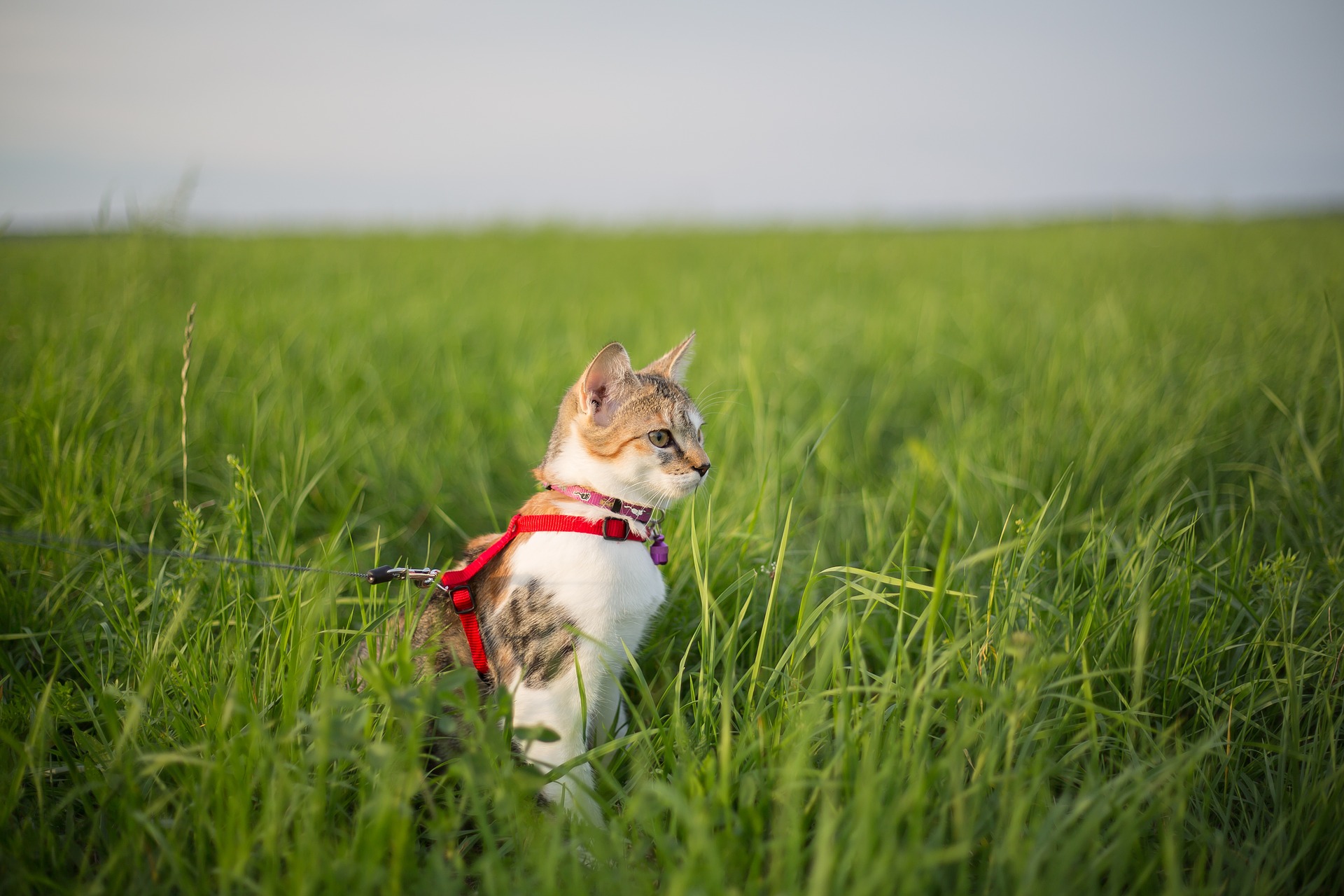
This article is contributed by guest writer, Emily Parker (author of Catological)
How To Safely Provide Your Cat With Outdoor Time
In years past, the belief about cats was they should be kept outdoors, where they could be free to roam. They are predators, after all!
However, while people used to believe cats could not be happy unless they were outside, there is a much greater understanding today of the many hazards cats face when left outdoors to fend for themselves.
Whether it’s other animals or vehicles, there are numerous dangers awaiting your furry feline in the great outdoors. Fortunately, there are now options available to let your cat safely have plenty of outdoor time. If your precious kitty does manage to escape make sure to read our 7 Effective Search Tips for Find Your Lost Cat article.
Here are some safe ways to guarantee your favorite feline will have plenty of outdoor time, without the risk of her running away.

Photo Credit: g3gg0 via Pixabay
1. Cat Leash and Harness
While people are very familiar with walking dogs on a leash and harness, few people realize you can do the same with cats.
With a little training and patience, your cat will likely adapt to this pretty quickly, and will in fact come to look forward to walks with his or her favorite human.
But when you decide to try this method of enjoying the great outdoors, keep a few things in mind.
For starters, it is always best to purchase a very sturdy leash, harness, and possibly a walking jacket. If you don’t, and instead choose to simply attach a leash to your cat’s collar, there is a much greater chance they will slip out of the collar and run away, especially if they get scared by a strange dog or loud noise.
Test out your leash and harness by walking your cat inside for a week or two, then move to your yard. Initially, your cat may slink or belly-crawl, but will eventually get used to the feel of the leash and harness.
With some patience and encouragement from you, your kitty will come to act as if they have been using a leash all their life.

Photo Credit: Meowingtons
2. Personal Vest or Backpack Carrier
If you want to keep your cat close to your heart, consider purchasing a personal vest carrier for the outdoor excursions you and your kitty will experience.
Made much like vests parents use with newborn babies, these vest carriers are not only very easy to use, but also made to be very comfortable for your cat.
They can come with a mesh pocket, drawstrings, and metal clips that can attach to a harness, making them a very safe option for your cat.
More popular are the backpacks that allow you to go out and about like you normally would…just with your cat in tow!
They typically have a see-through “bubble” for your kitty to stick her head into in order to see the world around her, and can usually be worn on either your front or back.
These are great for getting your cat some new stimulation, but of course won’t provide any of the exercise or play benefits of being outdoors.

Photo Credit: Pacific Tail Pets
3. Walkers and Strollers
Another option to help your pet get fresh air without exercise or play (usually a great option for senior cats who don’t move around so well), is a cat stroller.
Just like you would use a walker or stroller for your human baby, you can do the same for your feline fur baby as well.
Human baby strollers are open, allowing the parent to see and interact with their baby, but pet walkers and strollers have zippered mesh areas that keep your kitty safely inside.
If you just like to walk around your neighborhood, there are less expensive options that have smaller, plastic wheels. But if you plan on navigating trails or bumpy terrain, there are some fantastic options with big, 4×4 style wheels that will allow for a super comfy ride for your kitty.

Photo Credit: fotografierende via Pexels
4. Temporary Enclosures
Made to resemble a typical tent you would use on a camping trip, temporary kitty enclosures are a great way to give your cat outdoor time in a safe, non-threatening environment.
The only difference between tents and these enclosures, is that the kitty enclosure is made of mesh allowing your cat to observe her surroundings.
Like a leash and harness combo, this one is meant to provide for some actual exercise and free-roaming.
Perfect to set up in your backyard, a neighborhood park, or in the great outdoors on a camping trip or vacation, they offer many great benefits.
Along with being very affordable, they fold up to be very compact when not in use.
And when it comes time to give your kitty some outdoor time, these enclosures simply pop open in a matter of seconds, requiring no assembly.
Offering enough room to let your cat stretch its legs, stalk a few bugs, and nibble on some grass, these enclosures are the perfect choice if you’re going to be spending time outside and don’t want your cat cooped up indoors.

Photo Credit: Catio Spaces
5. Catios
If you are ready to go all the way and give your cat the ultimate outdoor safety and roaming option, consider building a permanent enclosure…better known as a “catio” (sounds like “patio”).
Whether you want to give your favorite feline family member a simple one-room enclosure, or instead choose create a luxurious outdoor palace, the choice is yours.
For some pet parents, catios can become multi-story habitats, and include plenty of shelves, ladders, and in some cases tunnels that connect the catio to the owner’s home. Whatever your preference, budget, and space availability, a catio is something your cat is sure to love day after day.
Once you decide a catio is for you, there are numerous options you have in getting one built. If you are handy around the house, you can make this a do-it-yourself project. However, if you prefer to leave building your catio to the pros, there are actually comp companies that specialize in building them!

Photo Credit: pasja1000 via Pixabay
6. Cat Fencing
For those of you who want to let your cat experience the great outdoors to the fullest, cat fencing may be the best choice for you and your feline, offering full-on freedom while providing a great deal of safety.
With an assortment of styles and options available, cat fencing can be used in almost any type of backyard.
For some owners, freestanding fencing is the best option, since this can be put up and taken down once the kitty’s romp is over.
However, if you already have a fence around your yard, there are many types of barriers that can be installed on pre-existing fencing to keep your cat from escaping.
One of the most popular is a rolling metal barrier, which when installed at the top of your fence, will automatically roll over and over if your cat tries to climb over it. By rolling and being slippery, your cat will simply drop to the ground, and hopefully get discouraged enough after a few tries to give up.
But remember, if you have any trees or bushes in your yard that are located near fences, you may want to reconsider this option, or purchase and install tree guards to use in these areas.
Rather than take a chance on losing your beloved kitty, you can choose whichever of these options works best for you and your favorite feline. By doing so, not only will your kitty be able to enjoy its outdoor time safely, but you will also have peace of mind, knowing your kitty is safe and sound.

Linda Wolff
December 13, 2018 at 4:08 PMAnother tip … get your cat micro-chipped so if they do get loose they will more likely be returned to you. Micro chips are safer than a collar that can get caught on a fence or tree limb, Cats have also been known to slip their collars but that won’t happen with a micro chip.
Cara Jentzen
December 14, 2018 at 3:06 AMThe microchip makes it very easy to identify the deceased cat hit by the car😡 Not exactly the safest choice, but used as a safety net just in case. In suburban areas we still have coyotes, cars, and horrible humans who pick up kittens and cats and use them for “bait animals” for dog fighting. My two cats stay inside. We are considering the harness and leash though. But we are both retired, so our cats get all of our attention.
Kolbe
January 6, 2019 at 6:32 PMAlso, come to find out, if you let your cat roam and it gets into a fight with another cat it can get feline leukimia or FIV. This is what happened to my cat and she is microchipped.
Now she will sadly stuggle with being sick for the rest of her life 😭
Plus with microchips people have to go take the animal to the vet or humane society and more often than not that doesnt happen.
Tim
December 14, 2018 at 12:40 PMMy cat was stolen, there was a witness to the cat grab. If that person never takes him to the vet or two shelter, account will never get scammed and I’m still without my cat… It’s been since August since he’s been gone
joanne
January 2, 2019 at 3:59 PMI tried putting my boy Digit in a harness on a leash. He was like a bucking bronco until he got out of it.
Diane Hamilton
January 2, 2019 at 6:17 PMI have a microchip on my cat, but I don’t think they work. A person would have to catch the cat and take it to a vet to scan it.
Most people won’t pick up a stray cat. and take them to a vet. Also most cats would just run away if you tried to catch them.
K
January 4, 2019 at 2:30 PMNot necessarily true – from someone who volunteers in a tnr/rescue group, many cats show up on someone’s porch or in their yard looking for food, safety, or shelter. There are lots of posts on the lost and found facebook groups how a cat just showed up and has been hanging around. Also, if someone calls animal control or does TNR or takes them to a shelter, they get scanned for a microchip. For only $15-$25 at a low cost clinic, totally worth it. It more than doubles your chance of having your pet returned – but the #1 issue with microchips – people keeping it up to date. Make a yearly reminder to check all info is up to date!
“Q: Will a microchip really make it more likely for me to get my pet back if it is lost?
A: Definitely! A study of more than 7,700 stray animals at animal shelters showed that dogs without microchips were returned to their owners 21.9% of the time, whereas microchipped dogs were returned to their owners 52.2% of the time. Cats without microchips were reunited with their owners only 1.8% of the time, whereas microchipped cats went back home 38.5% of the time. (Lord et al, JAVMA, July 15, 2009) For microchipped animals that weren’t returned to their owners, most of the time it was due to incorrect owner information (or no owner information) in the microchip registry database – so don’t forget to register and keep your information updated.”
https://www.avma.org/KB/Resources/FAQs/Pages/Microchipping-of-animals-FAQ.aspx
V
January 5, 2019 at 4:20 PMWe help lost cats in our area. A kitty appeared on my patio in the few cold evenings we have here. I took kitty in. Later I brought the kitty to a vet. The microchip helped a lot . Thank heavens. The cat was reunited to its original home. The vet did a free check on the microchip. It is very helpful to update microchips too.
Noel Rundquist
January 13, 2019 at 7:30 AMHas anyone replied to a long haired mixed sianeese named cloud key,? We are still waiting for him to readpond missing last April 2018 from lake Bay wa